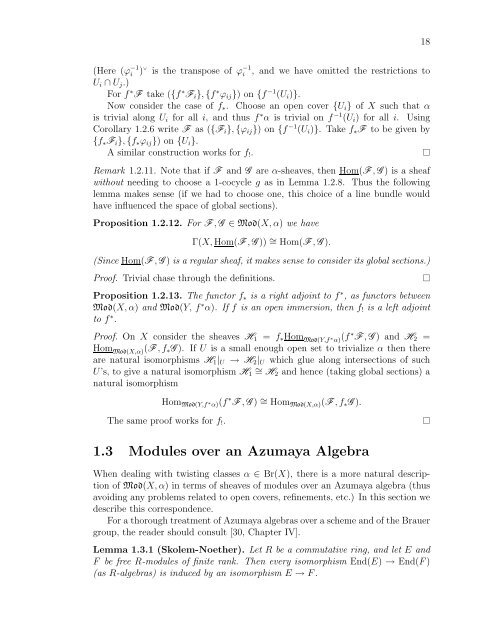derived categories of twisted sheaves on calabi-yau manifolds
derived categories of twisted sheaves on calabi-yau manifolds
derived categories of twisted sheaves on calabi-yau manifolds
You also want an ePaper? Increase the reach of your titles
YUMPU automatically turns print PDFs into web optimized ePapers that Google loves.
(Here (ϕ −1<br />
i )∨ is the transpose <str<strong>on</strong>g>of</str<strong>on</strong>g> ϕ −1<br />
i , and we have omitted the restricti<strong>on</strong>s to<br />
Ui ∩ Uj.)<br />
For f ∗ F take ({f ∗ Fi}, {f ∗ ϕij}) <strong>on</strong> {f −1 (Ui)}.<br />
Now c<strong>on</strong>sider the case <str<strong>on</strong>g>of</str<strong>on</strong>g> f∗. Choose an open cover {Ui} <str<strong>on</strong>g>of</str<strong>on</strong>g> X such that α<br />
is trivial al<strong>on</strong>g Ui for all i, and thus f ∗ α is trivial <strong>on</strong> f −1 (Ui) for all i. Using<br />
Corollary 1.2.6 write F as ({Fi}, {ϕij}) <strong>on</strong> {f −1 (Ui)}. Take f∗F to be given by<br />
{f∗Fi}, {f∗ϕij}) <strong>on</strong> {Ui}.<br />
A similar c<strong>on</strong>structi<strong>on</strong> works for f!.<br />
Remark 1.2.11. Note that if F and G are α-<str<strong>on</strong>g>sheaves</str<strong>on</strong>g>, then Hom(F , G ) is a sheaf<br />
without needing to choose a 1-cocycle g as in Lemma 1.2.8. Thus the following<br />
lemma makes sense (if we had to choose <strong>on</strong>e, this choice <str<strong>on</strong>g>of</str<strong>on</strong>g> a line bundle would<br />
have influenced the space <str<strong>on</strong>g>of</str<strong>on</strong>g> global secti<strong>on</strong>s).<br />
Propositi<strong>on</strong> 1.2.12. For F , G ∈ Mod(X, α) we have<br />
Γ(X, Hom(F , G )) ∼ = Hom(F , G ).<br />
(Since Hom(F , G ) is a regular sheaf, it makes sense to c<strong>on</strong>sider its global secti<strong>on</strong>s.)<br />
Pro<str<strong>on</strong>g>of</str<strong>on</strong>g>. Trivial chase through the definiti<strong>on</strong>s.<br />
Propositi<strong>on</strong> 1.2.13. The functor f∗ is a right adjoint to f ∗ , as functors between<br />
Mod(X, α) and Mod(Y, f ∗ α). If f is an open immersi<strong>on</strong>, then f! is a left adjoint<br />
to f ∗ .<br />
Pro<str<strong>on</strong>g>of</str<strong>on</strong>g>. On X c<strong>on</strong>sider the <str<strong>on</strong>g>sheaves</str<strong>on</strong>g> H1 = f∗Hom Mod(Y,f ∗ α)(f ∗ F , G ) and H2 =<br />
Hom Mod(X,α)(F , f∗G ). If U is a small enough open set to trivialize α then there<br />
are natural isomorphisms H1|U → H2|U which glue al<strong>on</strong>g intersecti<strong>on</strong>s <str<strong>on</strong>g>of</str<strong>on</strong>g> such<br />
U’s, to give a natural isomorphism H1 ∼ = H2 and hence (taking global secti<strong>on</strong>s) a<br />
natural isomorphism<br />
HomMod(Y,f ∗ α)(f ∗ F , G ) ∼ = HomMod(X,α)(F , f∗G ).<br />
The same pro<str<strong>on</strong>g>of</str<strong>on</strong>g> works for f!.<br />
1.3 Modules over an Azumaya Algebra<br />
When dealing with twisting classes α ∈ Br(X), there is a more natural descripti<strong>on</strong><br />
<str<strong>on</strong>g>of</str<strong>on</strong>g> Mod(X, α) in terms <str<strong>on</strong>g>of</str<strong>on</strong>g> <str<strong>on</strong>g>sheaves</str<strong>on</strong>g> <str<strong>on</strong>g>of</str<strong>on</strong>g> modules over an Azumaya algebra (thus<br />
avoiding any problems related to open covers, refinements, etc.) In this secti<strong>on</strong> we<br />
describe this corresp<strong>on</strong>dence.<br />
For a thorough treatment <str<strong>on</strong>g>of</str<strong>on</strong>g> Azumaya algebras over a scheme and <str<strong>on</strong>g>of</str<strong>on</strong>g> the Brauer<br />
group, the reader should c<strong>on</strong>sult [30, Chapter IV].<br />
Lemma 1.3.1 (Skolem-Noether). Let R be a commutative ring, and let E and<br />
F be free R-modules <str<strong>on</strong>g>of</str<strong>on</strong>g> finite rank. Then every isomorphism End(E) → End(F )<br />
(as R-algebras) is induced by an isomorphism E → F .<br />
18
















